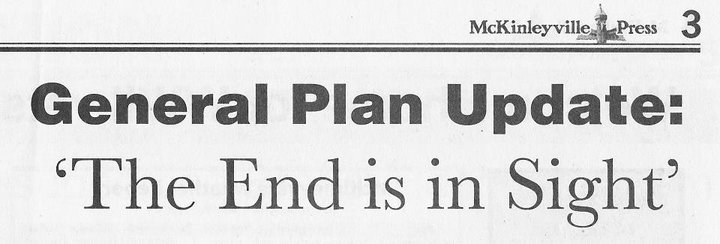
It was November of 1999 when the Humboldt County Board of Supervisors set out to update the county’s general plan.
This was the biggest song in the world at the time:
This movie was about to come out:
Cell phones looked like this:

Apple laptops looked like this:

The internet looked like this:

And everyone was freaked out about Y2K.
Here in Humboldt County, the Headwaters Forest Reserve had just been established, Julia Butterfly Hill was about to climb into the redwood tree she lived in for two years, and Kirk Girard, director of the county’s newly established Community Development Services Department, said staff hoped the General Plan Update would “be done in three or three and a half years.”
Here we are 18 years later and the thing’s still not complete, though the finish line is now in sight. The county has released the Final Environmental Impact Report (FEIR), and the Board of Supervisors is scheduled hold a public hearing three weeks from today to certify that document and, at long last, adopt the General Plan Update.
Why has the process taken so long? There are many answers, though none of them fully explain it. The general plan — a set of policies, programs and maps intended to guide land use and development in the county’s unincorporated areas — is complex. Updating that sucker, something that hadn’t been done since 1984, required staff, the Planning Commission and the Board of Supervisors to work through about 1,000 separate policies on a wide variety of issues.
There were workshops, study sessions and hundreds of public meetings around the county. And, inevitably, that process became politicized, with various stakeholders, special interest groups, tribes, activists and zealots of all stripes jostling for influence. Broadly, the fundamental tension lay between conservation-minded smart growth advocates, including local environmental nonprofits, and a diverse alliance of private property rights advocates, including members of the Humboldt Coalition for Property Rights (HumCPR).

Pretty much every local publication ran at least one headline like this one (from 2011) at some point in the last 15 years. | Image nabbed from Facebook.
Eventually, the elongated timeline of the process became an obstacle unto itself. As the years went by, new people got involved in the process without reviewing all the work that had come before. New supervisors got elected and set about changing the ideological makeup of the Planning Commission, revisiting policy decisions made by previous boards and even rewriting the guiding principles underpinning the whole process.
And it’s possible that the GPU could get delayed yet again. The FEIR, released last week, identified dozens of policies that will have “significant environmental impacts,” many of which were deemed “unmitigatable,” meaning there’s no avoiding them. Many other policies do have required mitigation measures, and local stakeholder groups may well object to those measures.
But for now, the General Plan Update adoption hearing remains scheduled for Oct. 23. All 236 pages of the FEIR can be downloaded from the county website, here. And if you’d like to see the significant unavoidable impacts identified in the document, click here for a summary.
We’ll leave you with one more chart-topping hit from 1999:
CLICK TO MANAGE